Financial Ratio Analysis Report: Comparing REG and EHE Financials
VerifiedAdded on 2022/09/18
|9
|1250
|25
Report
AI Summary
This report presents a comprehensive financial ratio analysis of two ASX-listed healthcare companies, REG and EHE, over a three-year period (2016-2018). The analysis includes the calculation and interpretation of key financial ratios such as net profit margin, asset turnover, current ratio, quick ratio, and debt ratio. The report examines the trends in these ratios for both companies, comparing their performance and identifying strengths and weaknesses. Furthermore, the report delves into the cash cycle components, including inventory turnover, accounts receivable turnover, and accounts payable turnover, providing a deeper understanding of working capital management. The findings highlight the financial positions of both companies, with recommendations for improvement, focusing on aspects like profitability, liquidity, and solvency. The analysis is supported by data from the companies' annual financial reports and provides a clear understanding of the financial performance of each company relative to its competitor.
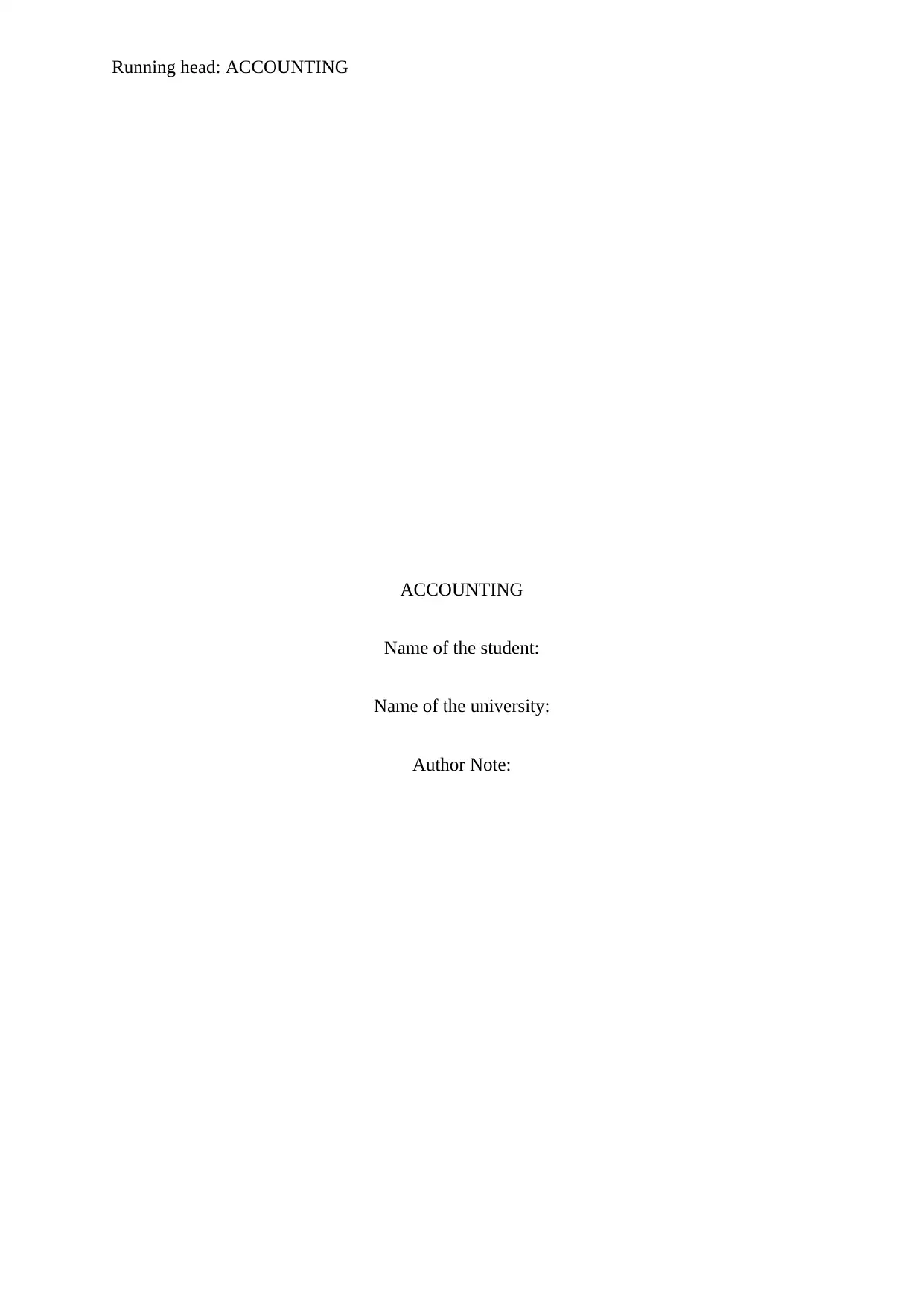
Running head: ACCOUNTING
ACCOUNTING
Name of the student:
Name of the university:
Author Note:
ACCOUNTING
Name of the student:
Name of the university:
Author Note:
Paraphrase This Document
Need a fresh take? Get an instant paraphrase of this document with our AI Paraphraser
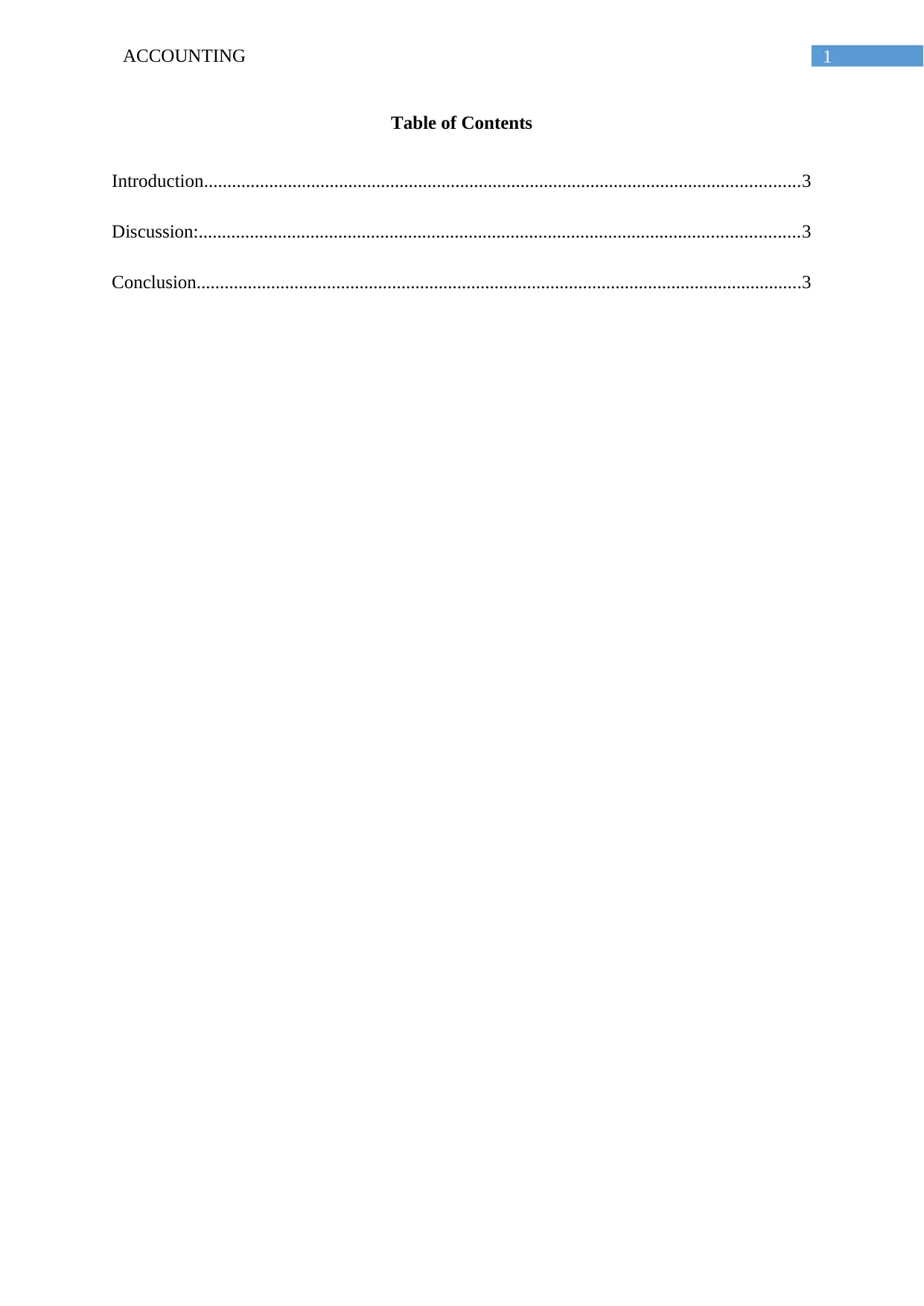
1ACCOUNTING
Table of Contents
Introduction................................................................................................................................3
Discussion:.................................................................................................................................3
Conclusion..................................................................................................................................3
Table of Contents
Introduction................................................................................................................................3
Discussion:.................................................................................................................................3
Conclusion..................................................................................................................................3
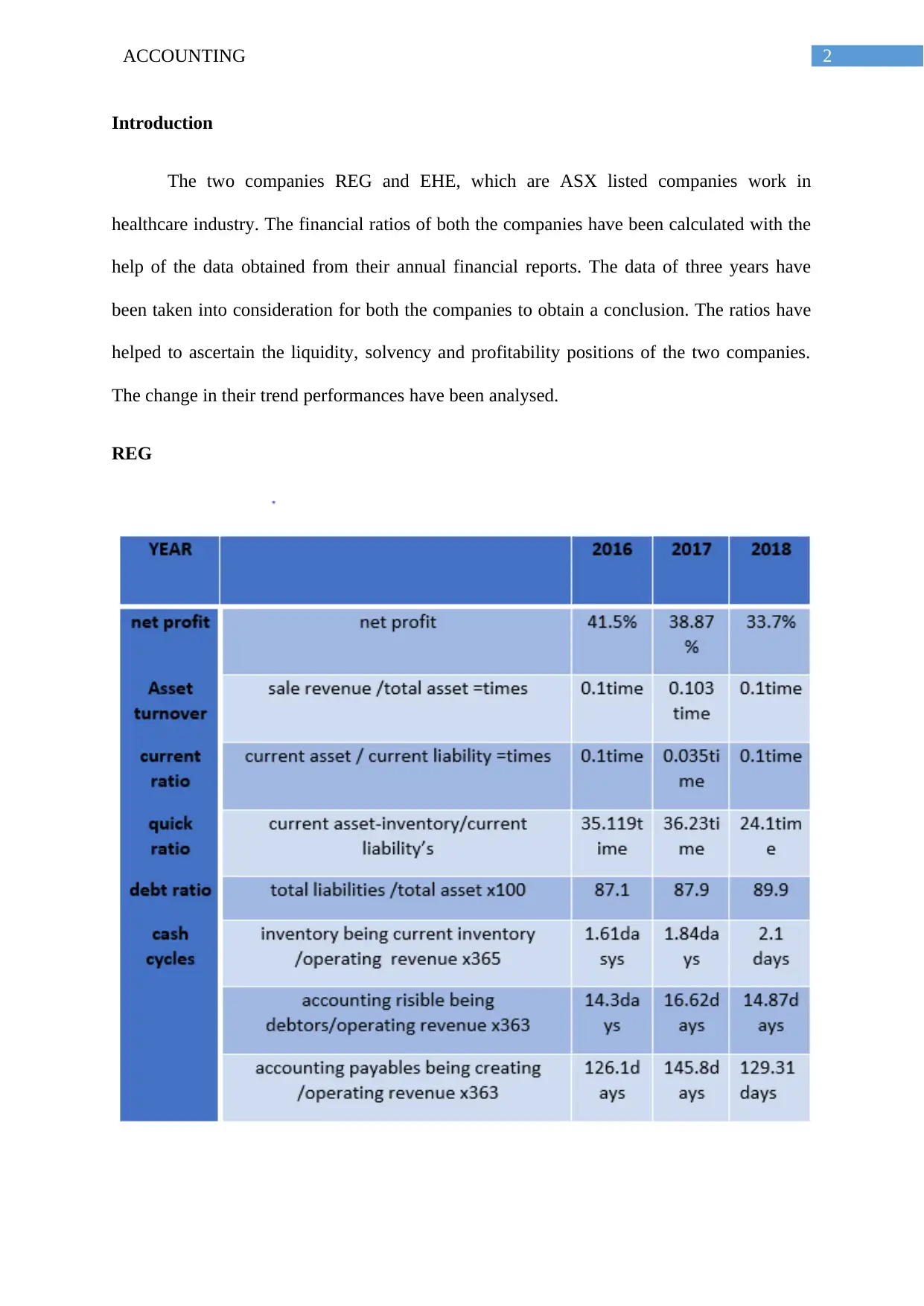
2ACCOUNTING
Introduction
The two companies REG and EHE, which are ASX listed companies work in
healthcare industry. The financial ratios of both the companies have been calculated with the
help of the data obtained from their annual financial reports. The data of three years have
been taken into consideration for both the companies to obtain a conclusion. The ratios have
helped to ascertain the liquidity, solvency and profitability positions of the two companies.
The change in their trend performances have been analysed.
REG
Introduction
The two companies REG and EHE, which are ASX listed companies work in
healthcare industry. The financial ratios of both the companies have been calculated with the
help of the data obtained from their annual financial reports. The data of three years have
been taken into consideration for both the companies to obtain a conclusion. The ratios have
helped to ascertain the liquidity, solvency and profitability positions of the two companies.
The change in their trend performances have been analysed.
REG
⊘ This is a preview!⊘
Do you want full access?
Subscribe today to unlock all pages.

Trusted by 1+ million students worldwide
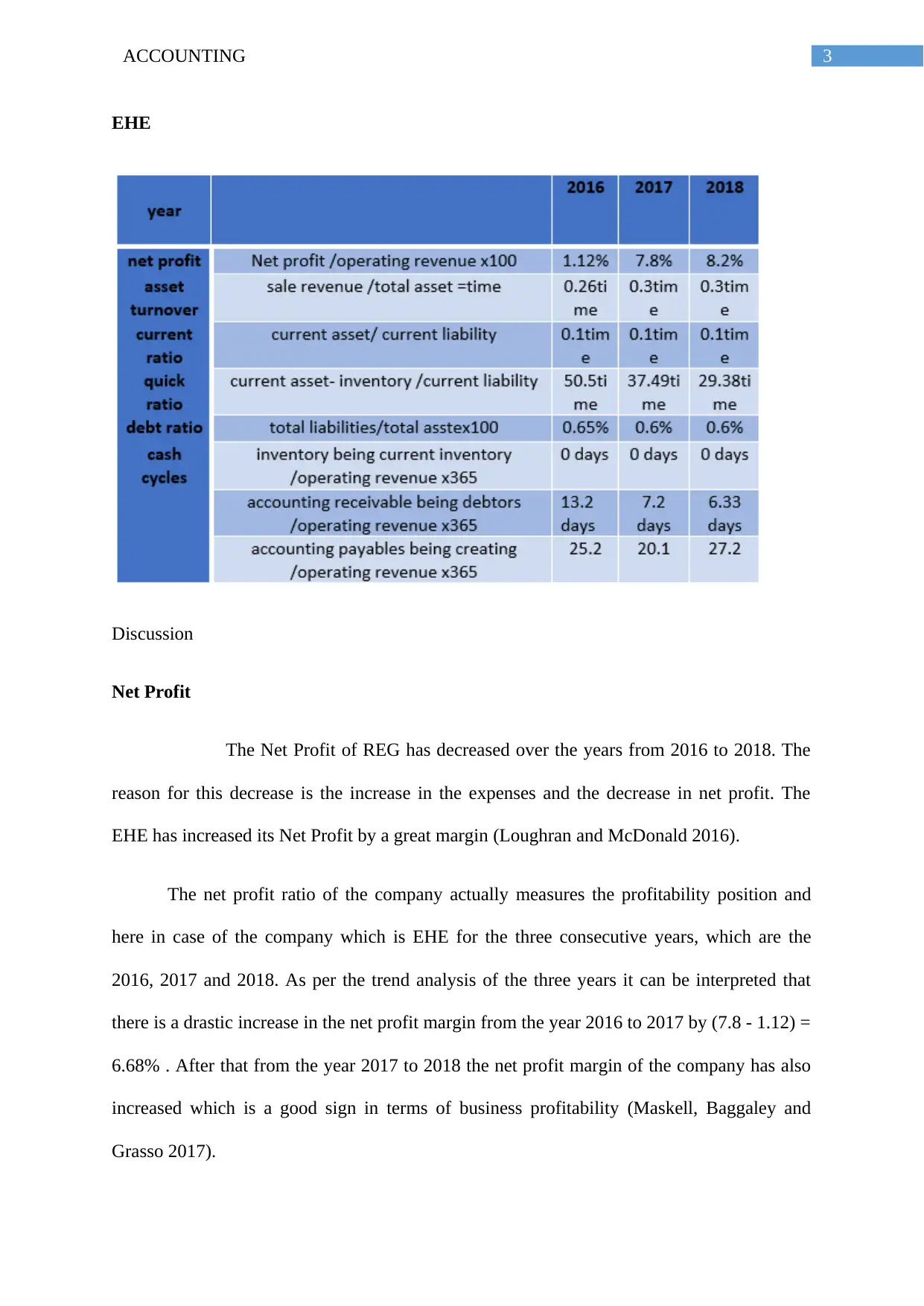
3ACCOUNTING
EHE
Discussion
Net Profit
The Net Profit of REG has decreased over the years from 2016 to 2018. The
reason for this decrease is the increase in the expenses and the decrease in net profit. The
EHE has increased its Net Profit by a great margin (Loughran and McDonald 2016).
The net profit ratio of the company actually measures the profitability position and
here in case of the company which is EHE for the three consecutive years, which are the
2016, 2017 and 2018. As per the trend analysis of the three years it can be interpreted that
there is a drastic increase in the net profit margin from the year 2016 to 2017 by (7.8 - 1.12) =
6.68% . After that from the year 2017 to 2018 the net profit margin of the company has also
increased which is a good sign in terms of business profitability (Maskell, Baggaley and
Grasso 2017).
EHE
Discussion
Net Profit
The Net Profit of REG has decreased over the years from 2016 to 2018. The
reason for this decrease is the increase in the expenses and the decrease in net profit. The
EHE has increased its Net Profit by a great margin (Loughran and McDonald 2016).
The net profit ratio of the company actually measures the profitability position and
here in case of the company which is EHE for the three consecutive years, which are the
2016, 2017 and 2018. As per the trend analysis of the three years it can be interpreted that
there is a drastic increase in the net profit margin from the year 2016 to 2017 by (7.8 - 1.12) =
6.68% . After that from the year 2017 to 2018 the net profit margin of the company has also
increased which is a good sign in terms of business profitability (Maskell, Baggaley and
Grasso 2017).
Paraphrase This Document
Need a fresh take? Get an instant paraphrase of this document with our AI Paraphraser
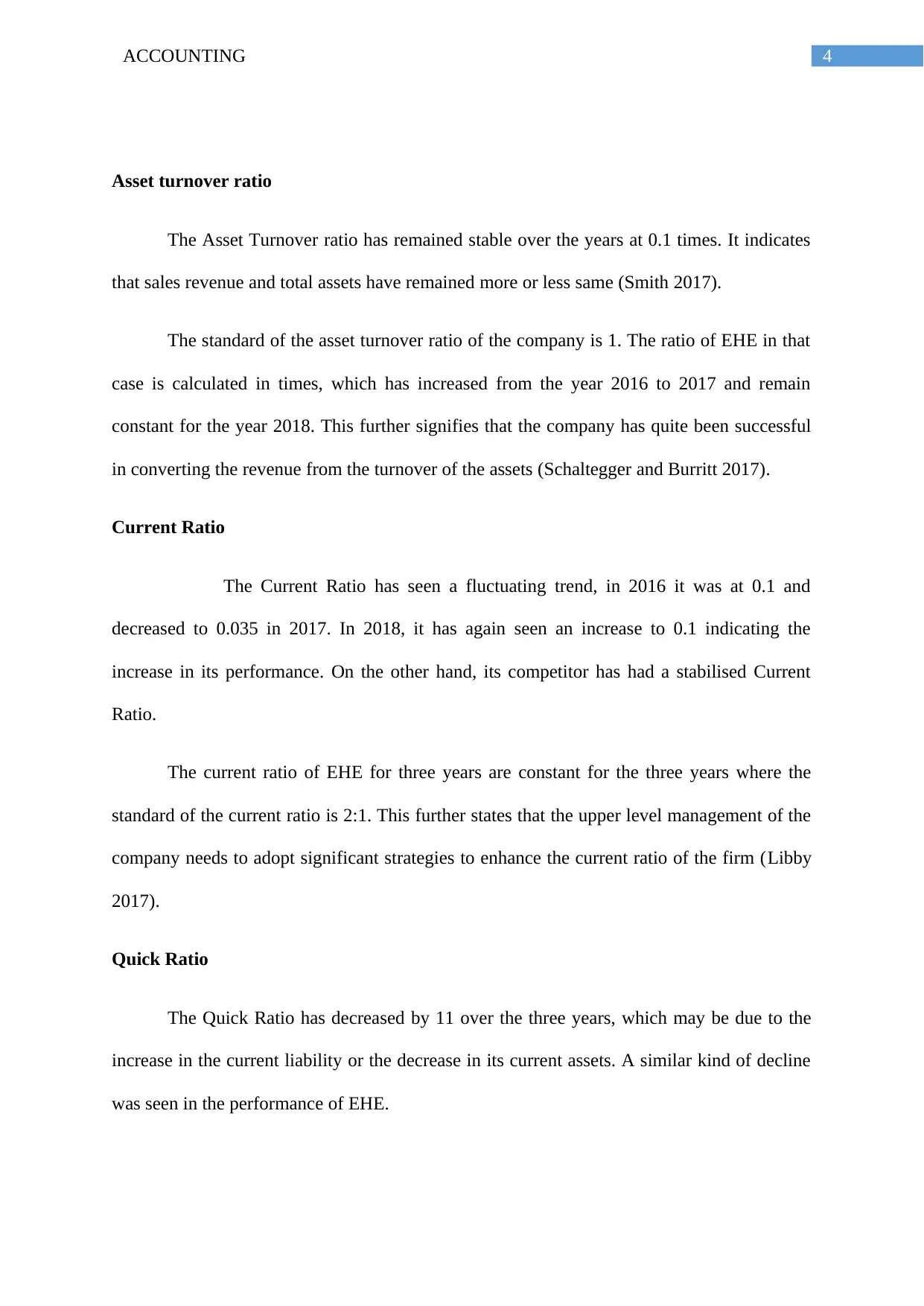
4ACCOUNTING
Asset turnover ratio
The Asset Turnover ratio has remained stable over the years at 0.1 times. It indicates
that sales revenue and total assets have remained more or less same (Smith 2017).
The standard of the asset turnover ratio of the company is 1. The ratio of EHE in that
case is calculated in times, which has increased from the year 2016 to 2017 and remain
constant for the year 2018. This further signifies that the company has quite been successful
in converting the revenue from the turnover of the assets (Schaltegger and Burritt 2017).
Current Ratio
The Current Ratio has seen a fluctuating trend, in 2016 it was at 0.1 and
decreased to 0.035 in 2017. In 2018, it has again seen an increase to 0.1 indicating the
increase in its performance. On the other hand, its competitor has had a stabilised Current
Ratio.
The current ratio of EHE for three years are constant for the three years where the
standard of the current ratio is 2:1. This further states that the upper level management of the
company needs to adopt significant strategies to enhance the current ratio of the firm (Libby
2017).
Quick Ratio
The Quick Ratio has decreased by 11 over the three years, which may be due to the
increase in the current liability or the decrease in its current assets. A similar kind of decline
was seen in the performance of EHE.
Asset turnover ratio
The Asset Turnover ratio has remained stable over the years at 0.1 times. It indicates
that sales revenue and total assets have remained more or less same (Smith 2017).
The standard of the asset turnover ratio of the company is 1. The ratio of EHE in that
case is calculated in times, which has increased from the year 2016 to 2017 and remain
constant for the year 2018. This further signifies that the company has quite been successful
in converting the revenue from the turnover of the assets (Schaltegger and Burritt 2017).
Current Ratio
The Current Ratio has seen a fluctuating trend, in 2016 it was at 0.1 and
decreased to 0.035 in 2017. In 2018, it has again seen an increase to 0.1 indicating the
increase in its performance. On the other hand, its competitor has had a stabilised Current
Ratio.
The current ratio of EHE for three years are constant for the three years where the
standard of the current ratio is 2:1. This further states that the upper level management of the
company needs to adopt significant strategies to enhance the current ratio of the firm (Libby
2017).
Quick Ratio
The Quick Ratio has decreased by 11 over the three years, which may be due to the
increase in the current liability or the decrease in its current assets. A similar kind of decline
was seen in the performance of EHE.
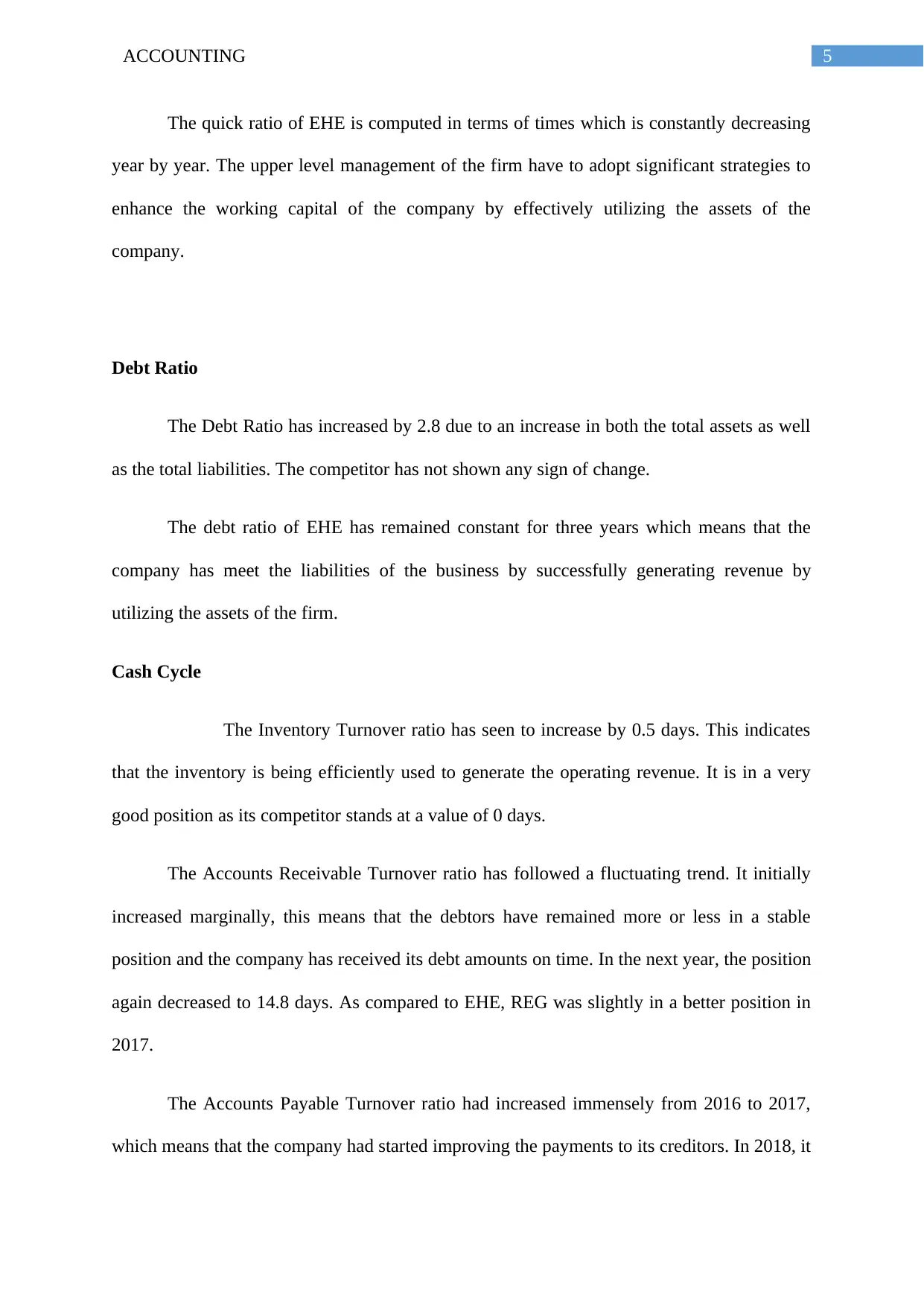
5ACCOUNTING
The quick ratio of EHE is computed in terms of times which is constantly decreasing
year by year. The upper level management of the firm have to adopt significant strategies to
enhance the working capital of the company by effectively utilizing the assets of the
company.
Debt Ratio
The Debt Ratio has increased by 2.8 due to an increase in both the total assets as well
as the total liabilities. The competitor has not shown any sign of change.
The debt ratio of EHE has remained constant for three years which means that the
company has meet the liabilities of the business by successfully generating revenue by
utilizing the assets of the firm.
Cash Cycle
The Inventory Turnover ratio has seen to increase by 0.5 days. This indicates
that the inventory is being efficiently used to generate the operating revenue. It is in a very
good position as its competitor stands at a value of 0 days.
The Accounts Receivable Turnover ratio has followed a fluctuating trend. It initially
increased marginally, this means that the debtors have remained more or less in a stable
position and the company has received its debt amounts on time. In the next year, the position
again decreased to 14.8 days. As compared to EHE, REG was slightly in a better position in
2017.
The Accounts Payable Turnover ratio had increased immensely from 2016 to 2017,
which means that the company had started improving the payments to its creditors. In 2018, it
The quick ratio of EHE is computed in terms of times which is constantly decreasing
year by year. The upper level management of the firm have to adopt significant strategies to
enhance the working capital of the company by effectively utilizing the assets of the
company.
Debt Ratio
The Debt Ratio has increased by 2.8 due to an increase in both the total assets as well
as the total liabilities. The competitor has not shown any sign of change.
The debt ratio of EHE has remained constant for three years which means that the
company has meet the liabilities of the business by successfully generating revenue by
utilizing the assets of the firm.
Cash Cycle
The Inventory Turnover ratio has seen to increase by 0.5 days. This indicates
that the inventory is being efficiently used to generate the operating revenue. It is in a very
good position as its competitor stands at a value of 0 days.
The Accounts Receivable Turnover ratio has followed a fluctuating trend. It initially
increased marginally, this means that the debtors have remained more or less in a stable
position and the company has received its debt amounts on time. In the next year, the position
again decreased to 14.8 days. As compared to EHE, REG was slightly in a better position in
2017.
The Accounts Payable Turnover ratio had increased immensely from 2016 to 2017,
which means that the company had started improving the payments to its creditors. In 2018, it
⊘ This is a preview!⊘
Do you want full access?
Subscribe today to unlock all pages.

Trusted by 1+ million students worldwide
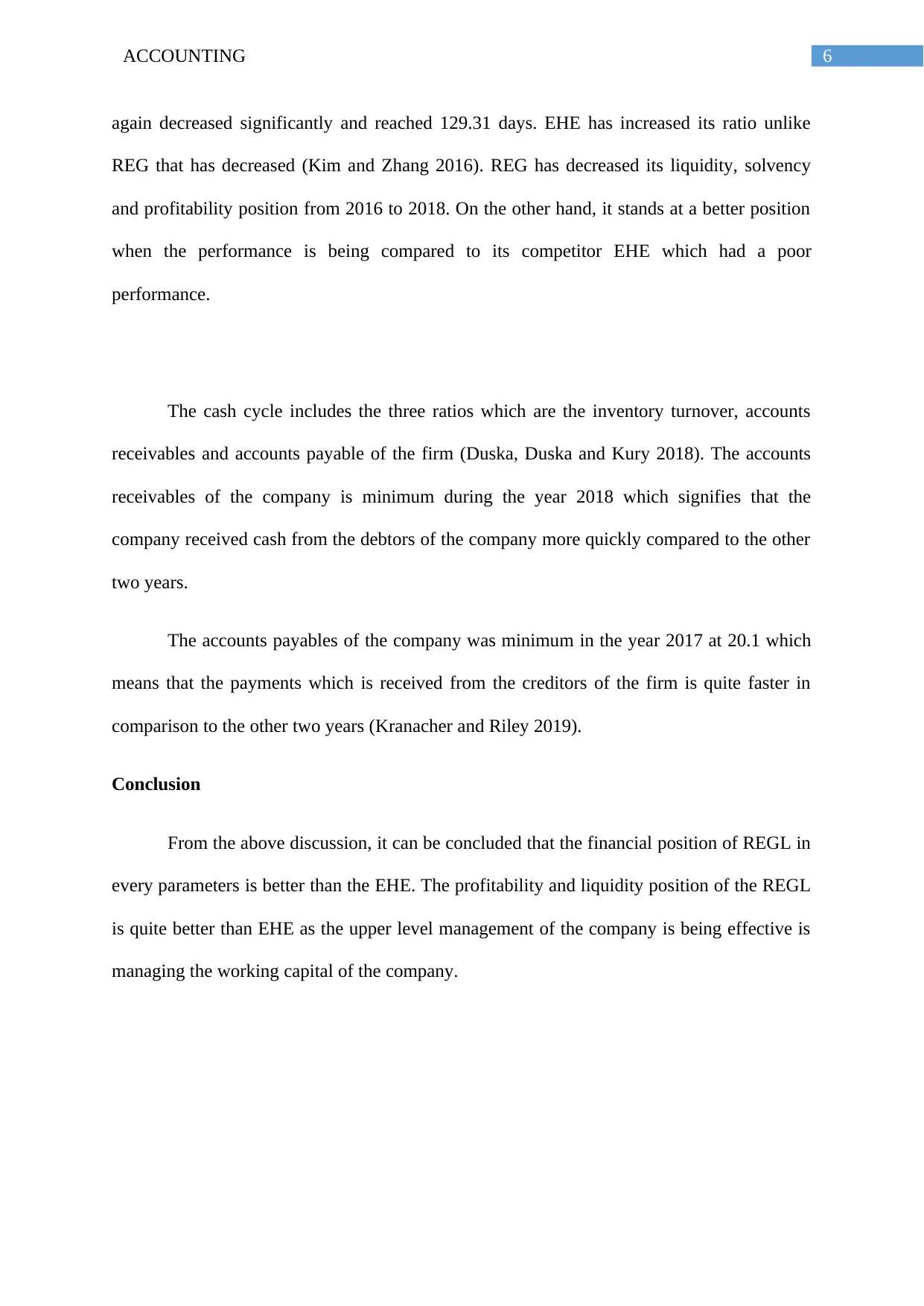
6ACCOUNTING
again decreased significantly and reached 129.31 days. EHE has increased its ratio unlike
REG that has decreased (Kim and Zhang 2016). REG has decreased its liquidity, solvency
and profitability position from 2016 to 2018. On the other hand, it stands at a better position
when the performance is being compared to its competitor EHE which had a poor
performance.
The cash cycle includes the three ratios which are the inventory turnover, accounts
receivables and accounts payable of the firm (Duska, Duska and Kury 2018). The accounts
receivables of the company is minimum during the year 2018 which signifies that the
company received cash from the debtors of the company more quickly compared to the other
two years.
The accounts payables of the company was minimum in the year 2017 at 20.1 which
means that the payments which is received from the creditors of the firm is quite faster in
comparison to the other two years (Kranacher and Riley 2019).
Conclusion
From the above discussion, it can be concluded that the financial position of REGL in
every parameters is better than the EHE. The profitability and liquidity position of the REGL
is quite better than EHE as the upper level management of the company is being effective is
managing the working capital of the company.
again decreased significantly and reached 129.31 days. EHE has increased its ratio unlike
REG that has decreased (Kim and Zhang 2016). REG has decreased its liquidity, solvency
and profitability position from 2016 to 2018. On the other hand, it stands at a better position
when the performance is being compared to its competitor EHE which had a poor
performance.
The cash cycle includes the three ratios which are the inventory turnover, accounts
receivables and accounts payable of the firm (Duska, Duska and Kury 2018). The accounts
receivables of the company is minimum during the year 2018 which signifies that the
company received cash from the debtors of the company more quickly compared to the other
two years.
The accounts payables of the company was minimum in the year 2017 at 20.1 which
means that the payments which is received from the creditors of the firm is quite faster in
comparison to the other two years (Kranacher and Riley 2019).
Conclusion
From the above discussion, it can be concluded that the financial position of REGL in
every parameters is better than the EHE. The profitability and liquidity position of the REGL
is quite better than EHE as the upper level management of the company is being effective is
managing the working capital of the company.
Paraphrase This Document
Need a fresh take? Get an instant paraphrase of this document with our AI Paraphraser
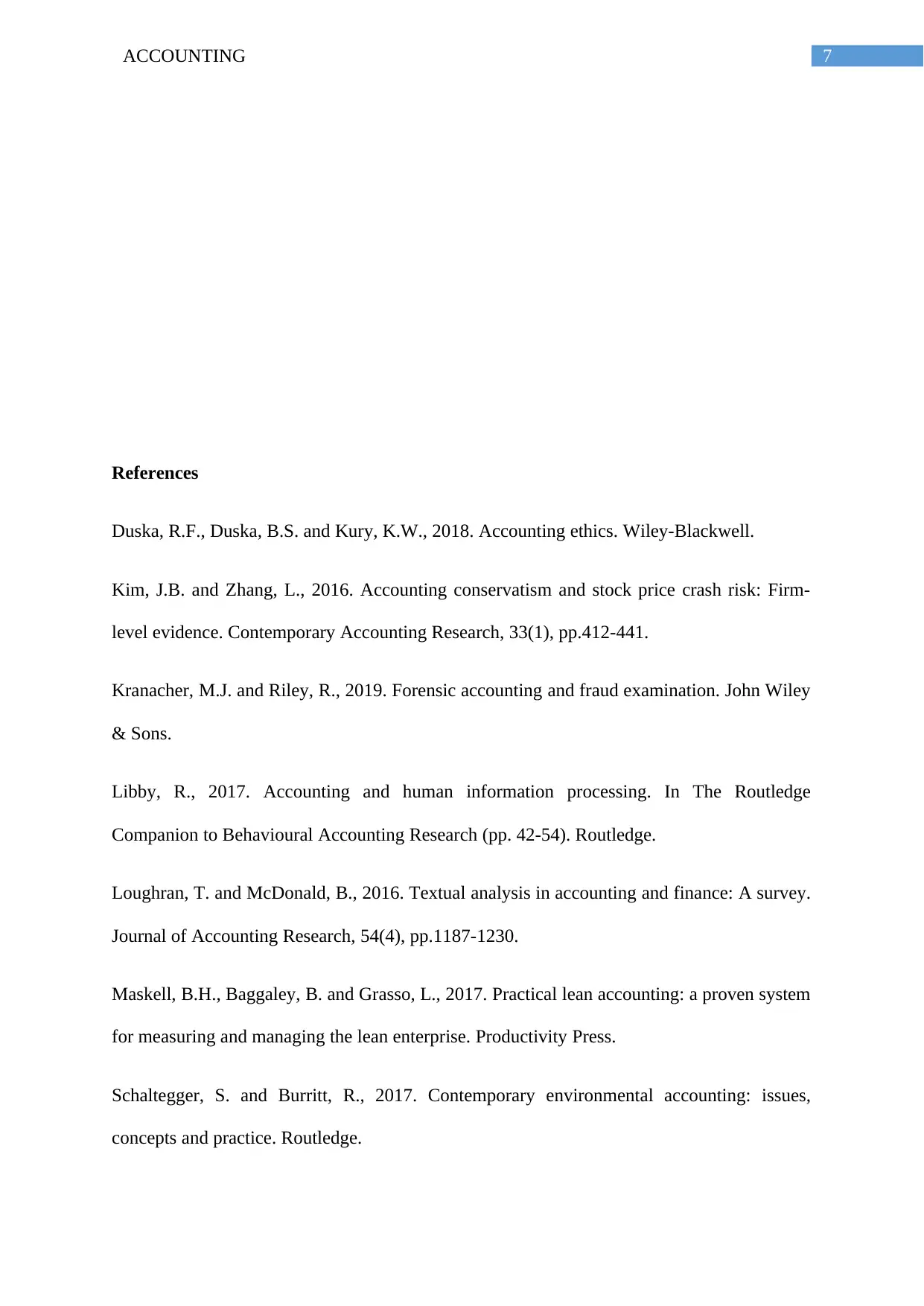
7ACCOUNTING
References
Duska, R.F., Duska, B.S. and Kury, K.W., 2018. Accounting ethics. Wiley-Blackwell.
Kim, J.B. and Zhang, L., 2016. Accounting conservatism and stock price crash risk: Firm‐
level evidence. Contemporary Accounting Research, 33(1), pp.412-441.
Kranacher, M.J. and Riley, R., 2019. Forensic accounting and fraud examination. John Wiley
& Sons.
Libby, R., 2017. Accounting and human information processing. In The Routledge
Companion to Behavioural Accounting Research (pp. 42-54). Routledge.
Loughran, T. and McDonald, B., 2016. Textual analysis in accounting and finance: A survey.
Journal of Accounting Research, 54(4), pp.1187-1230.
Maskell, B.H., Baggaley, B. and Grasso, L., 2017. Practical lean accounting: a proven system
for measuring and managing the lean enterprise. Productivity Press.
Schaltegger, S. and Burritt, R., 2017. Contemporary environmental accounting: issues,
concepts and practice. Routledge.
References
Duska, R.F., Duska, B.S. and Kury, K.W., 2018. Accounting ethics. Wiley-Blackwell.
Kim, J.B. and Zhang, L., 2016. Accounting conservatism and stock price crash risk: Firm‐
level evidence. Contemporary Accounting Research, 33(1), pp.412-441.
Kranacher, M.J. and Riley, R., 2019. Forensic accounting and fraud examination. John Wiley
& Sons.
Libby, R., 2017. Accounting and human information processing. In The Routledge
Companion to Behavioural Accounting Research (pp. 42-54). Routledge.
Loughran, T. and McDonald, B., 2016. Textual analysis in accounting and finance: A survey.
Journal of Accounting Research, 54(4), pp.1187-1230.
Maskell, B.H., Baggaley, B. and Grasso, L., 2017. Practical lean accounting: a proven system
for measuring and managing the lean enterprise. Productivity Press.
Schaltegger, S. and Burritt, R., 2017. Contemporary environmental accounting: issues,
concepts and practice. Routledge.
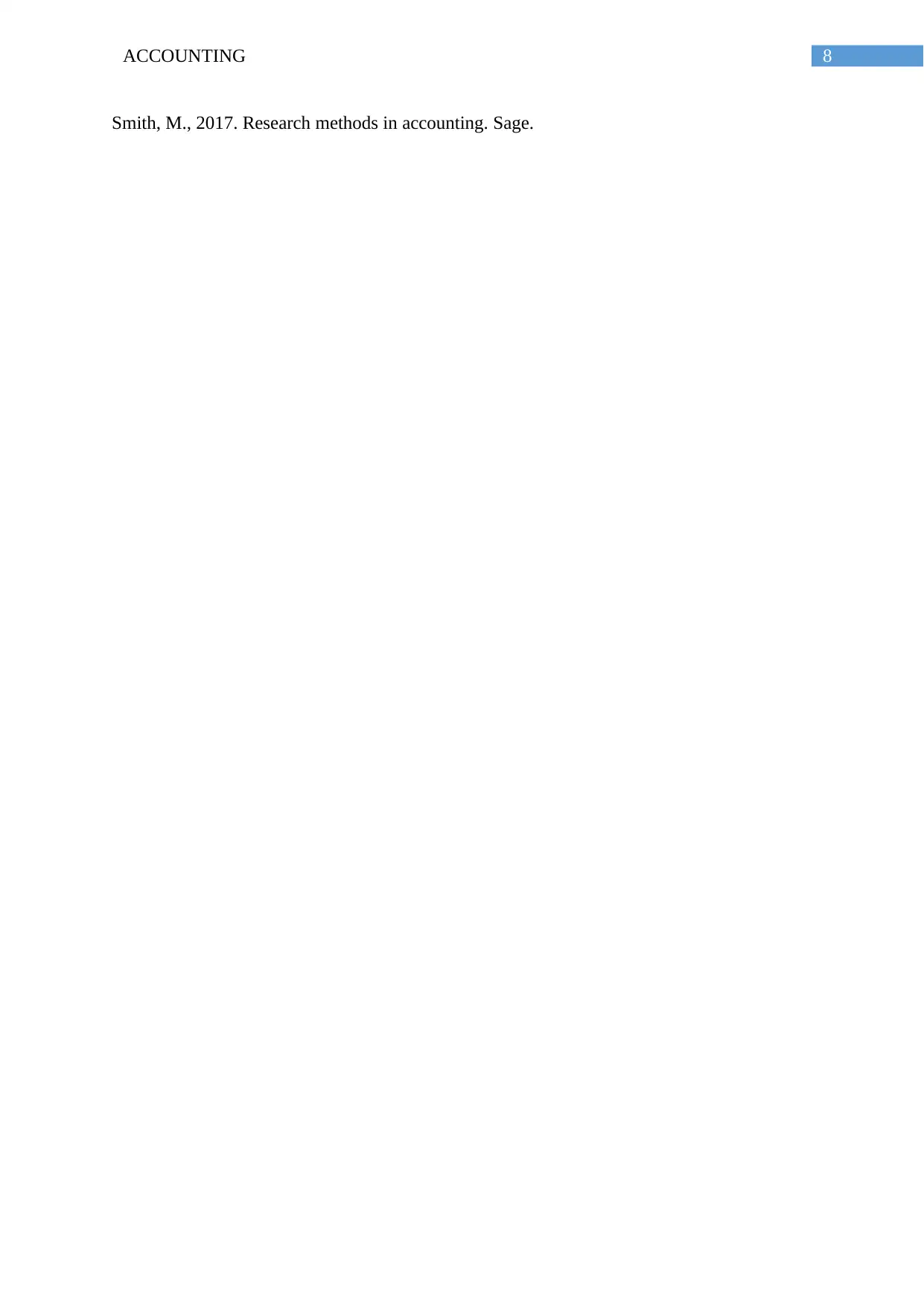
8ACCOUNTING
Smith, M., 2017. Research methods in accounting. Sage.
Smith, M., 2017. Research methods in accounting. Sage.
⊘ This is a preview!⊘
Do you want full access?
Subscribe today to unlock all pages.

Trusted by 1+ million students worldwide
1 out of 9
Related Documents
Your All-in-One AI-Powered Toolkit for Academic Success.
+13062052269
info@desklib.com
Available 24*7 on WhatsApp / Email
![[object Object]](/_next/static/media/star-bottom.7253800d.svg)
Unlock your academic potential
Copyright © 2020–2025 A2Z Services. All Rights Reserved. Developed and managed by ZUCOL.





